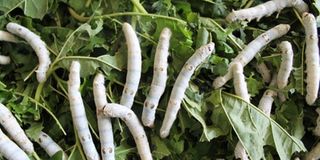Breeding silk worms: Some lessons to learn from Kenya

The silkworms feeding on mulberry leaves. PHOTO BY LOMINDA AFEDRARU
In Africa, the demand for raw silk is huge, especially in the textile industry. but farmers have not been sensitised to adapt sericulture—the rearing of silk worms, unlike in Kenya where Kenya Agriculture and Livestock Research Organisation (KALRO) breeds silkworms to strengthen the capacity of smallholder farmers engaged in silk farming in Kenya.
Objectives
The breed of interest for the research insitute is mulberry silkworm, which is highly domesticated globally. The other kinds include Tasar, Eri, Muga, Anaphe, Fagara, Coan and non-insect silkworms such as Mussel and Spider.
Silkworms have been reared in Kenya since the 1970s though on a very small scale, and was monitored by the ministry of agriculture.
This was the background to the current research provided by Dr Muo Kasina, the director of KALRO’s sericulture centre.
It was at a recent Kenya Science Journalists Conference in Nairobi, organised by Media for Environment, Science, Health and Agriculture (Mesha).
KALRO formed a sericulture centre to breed silkworms and sell their eggs to farmers for rearing. The team started by planting mulberry trees, which are predominantly used for feeding silkworms. Young ones are fed on young leaves which are tender, and as they grow older, mature leaves are used for feeding them and it days up to 30 days to harvesting stage.
Today, the silkworm moth lives only in captivity and they have been domesticated so that they can no longer survive independently in nature, the reason why scientists in Kenya are advising farmers to engage in silk farming.
Prices and demand
From the pupa stage, it takes about seven days to become a mature insect which can fly off from the cocoon. So, the farmers are advised to sell these cocoons, which are dried prior to being processing for raw silk.
This way, a farmer will be able to obtain between 1.2-1.7kg of raw silk. A kilo sells KShs5,000 (UShs165,000). Currently, the silk farmers are being encouraged to form cooperatives. Through these, they will process raw silk and sell via bulking to earn better prices as well as sustain the demand.
The demand exists in textile industries that rely on imports, which is rather expensive.
In Asian countries raw silk is used for processing textile, cosmetic products such as shampoo, lotion, lipsticks, jelly and tooth paste, among others, depending on the type of the silkworm.
Herbal food products are also processed from silk protein. It can as well be consumed in its insect form.
Extend research findings
Cosmetics making industries develop proteins from the cocoons using chemicals to dissolve them unlike the textile industry where fibre has to be processed from raw silk.
Research on silkworm at the KALRO sericulture centre started in March 2015. There is a five-year plan to develop the research capacity by obtaining the required silkworm breeds for the farmers to rear for good quality raw silk.
KALRO obtained the silkworms, they are currently breeding, from Japan.
But the challenge is them being infested with Nuclear Polyhedrosis Virus, which ends up killing them.
The farmers are usually advised to keep the worms well during breeding to avoid diseases.
Following the five-year plan, KALRO intends to be in position to extend the research to other East African countries. The findings and lessons learned will be of benefit to Uganda, where although sericulture was introduced, the breeding of silkworms has not taken off.
What are silkworms
Silkworms are the larvae of a moth native to Asian spins cocoon of fine strong, shiny fibre that is the source of commercial silk.
The culture of silkworms is called sericulture and the various species raised today are distinguished by the quality of the silk they produce.
Silk worms feed on leaves of the mulberries and sometimes the Osade orange species and the offer great nutritional value since they contain protein.
Young silkworms can even be fed so they will grow to a desired size. They are soft-bodied, slow-moving and can grow to three inches in length. They are also relatively fast growing, reaching about three inches in length and ready to cocoon in as little as 25-28 days.
Silkworms go through four stages of development, as do most insects: egg, larva, pupa and adult.
The adult stage is the silkworm moth and the larva is the caterpillar. The pupa is what the silkworm changes into after spinning its cocoon before emerging as a moth and since it grows so much, it must shed its skin four times while it is growing.
Worms and silk
The countries in Africa that breed silkworms and produce (raw) silk include Botswana, Egypt, Ethiopia, Ghana, Madagascar, Nigeria, Rwanda, South Africa, Tunisia, Zambia, Zimbabwe
Globally, there is China, India, Afghanistan, Bangladesh, Brazil, N Korea, France, Greece, Indonesia, Iran, Japan, Romania, Syria, Thailand, Uzbekistan, S Korea, Vietnam, Colombia, Nepal, Bulgaria, Turkey, Malaysia, Bolivia.
The major consumers are USA, Italy, Japan, India, France, China, United Kingdom, Switzerland, Germany, UAE, Korea and Vietnam.




